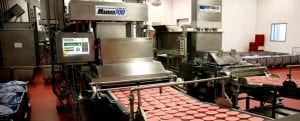Food processors have long ago learned that the secret to running a profitable facility doesn’t just lie in the volume of product they produce, but in how efficiently they make it. Under constant pressure from farmers and growers on one side, and retailers and foodservice organizations on the other, and with ever-changing legislation coming from local and federal governments, even the smallest inefficiencies can have significant effects on profitability. One of the tools food processors have in their toolbox is overall equipment effectiveness (OEE). But what is OEE and how do the most successful food manufacturers use it?
What is OEE?
OEE stands for overall equipment effectiveness. It is a measure of how close to optimal capacity a piece of production equipment is operated. OEE is measured as a percentage of actual productivity compared to optimal capability.
If a piece of production equipment is manufacturing high quality product as it’s peak output rate with no downtime, then it would have an OEE score of 100%.
But if that machine is sometimes producing substandard product, is operating below peak output or has downtime, then the OEE score decreases. Naturally, the most ideal scenario for food processors is to have all equipment running at 100% OEE score.
OEE is about tracking, understanding and managing the setup and operation of not only production equipment but the overall production processes to achieve the highest level of production output.
Factors That Affect OEE
While OEE specifically pertains to equipment effectiveness, the factors that affect OEE extend well beyond the hardware and software that compose a machine.
Common causes of reduced OEE:
- Raw Material Quality – One of the considerations of OEE is the production of high-quality product. If poor- or low-quality raw material is being fed into a piece of production equipment, then it is more likely to output substandard WIP or finished goods. Imagine a piece of bone that gets caught in a grinder, causing the machine to stop so the bone chunk can be removed, or low quality with too high fat content being used to create ground meat product. As soon as a piece of equipment stops or begins producing product that must be reworked, downgraded or disposed of, the overall equipment effectiveness score decreases.
- Production Scheduling, Product Changeovers or Product Starvation – Another of the key considerations of OEE is machine downtime. If a machine is not producing, then it’s OEE score will decrease. But machine downtime can result from reasons other than the machine being turned off or having maintenance issues: if production is not scheduled, the production line has been stopped to change from product to another, or if product is not being fed into the machine then the machine will not be producing output, thereby reducing its OEE score.
- Reduced Machine Performance or Maintenance Downtime – And then sometimes, downtime caused by the machine itself can also result in lower OEE. If parts of a machine break and must be fixed, the resulting maintenance downtime will have a negative effect on OEE. But the more common and less obvious version of this is if the machine is running sub optimally because of lack of preventative maintenance. The equipment’s production output may be lower than capacity, resulting in a lower OEE score.
- Human Factors – Human error can have a very significant influence on machine OEE. If the right input raw materials and ingredients are not added at the right time, then the machine might pause while waiting to continue its cycle. If the right product formulation is not followed, then the machine might produce lower quality product that may need to be further processed, reworked, downgraded or thrown out, or the machine may operate at a suboptimal level. All these factors can adversely affect the machine performance and lead to a lower OEE score.
- Utility or Environmental Conditions – Machines are also at the mercy of the utilities they draw from and their production environment. If there are voltage flickers on the power line, pressure deviations in the air supply or other fluctuations in the utilities the equipment uses, the machine performance – and consequently the OEE – might decrease. Similarly, most food processing environments are cold and have a lot of airborne moisture, and while most food processing equipment is purpose-built for these types of environments, factors such as the ambient temperature and humidity and rapid changes in these factors can affect machine operation and OEE.

Tracking, Understanding & Managing OEE
The most successful food processors are those that invest in concepts like tracking, understanding and managing the OEE scores. By progressively managing their production processes, they can identify those factors and occurrences that most significantly affect their OEE, which in turn impacts their operational performance and facility profitability.
With the right production management system, innovative processors identify the performance indicators that most significantly affect their overall production output, effectiveness and efficiency. By putting the right systems and processes in place, they track those key performance indicators, reacting to any exceptional deviations in real-time to reduce substandard, reworked or spoiled product. In many cases, they can further identify the underlying factors that indicate that production issues will happen before they actually happen. By taking this proactive approach they can circumvent production issues before they happen. By carefully tracking their quality and consistency of their raw materials, WIP and finished goods, they can maintain product quality and food safety standards.
Individually, these considerations can help achieve a higher level of performance and OEE, but when considered as part of an overall production management and food safety initiative, they can produce exceptional results and very short ROI’s.
Matrix helps food processors find the right technologies to improve production effectiveness and efficiency, driving results to the bottom line. If you’re looking for a partner to help you manage your plant floor technology systems, contact us and let’s chat about how we can help!